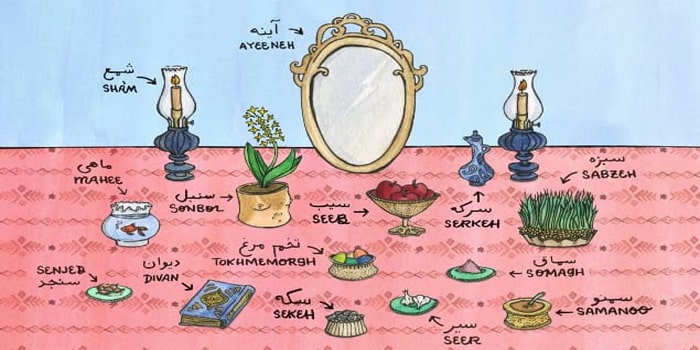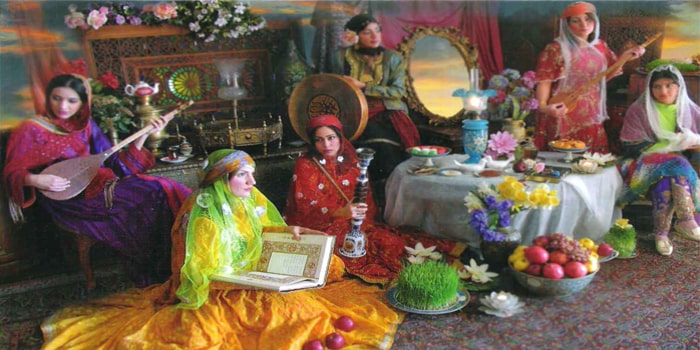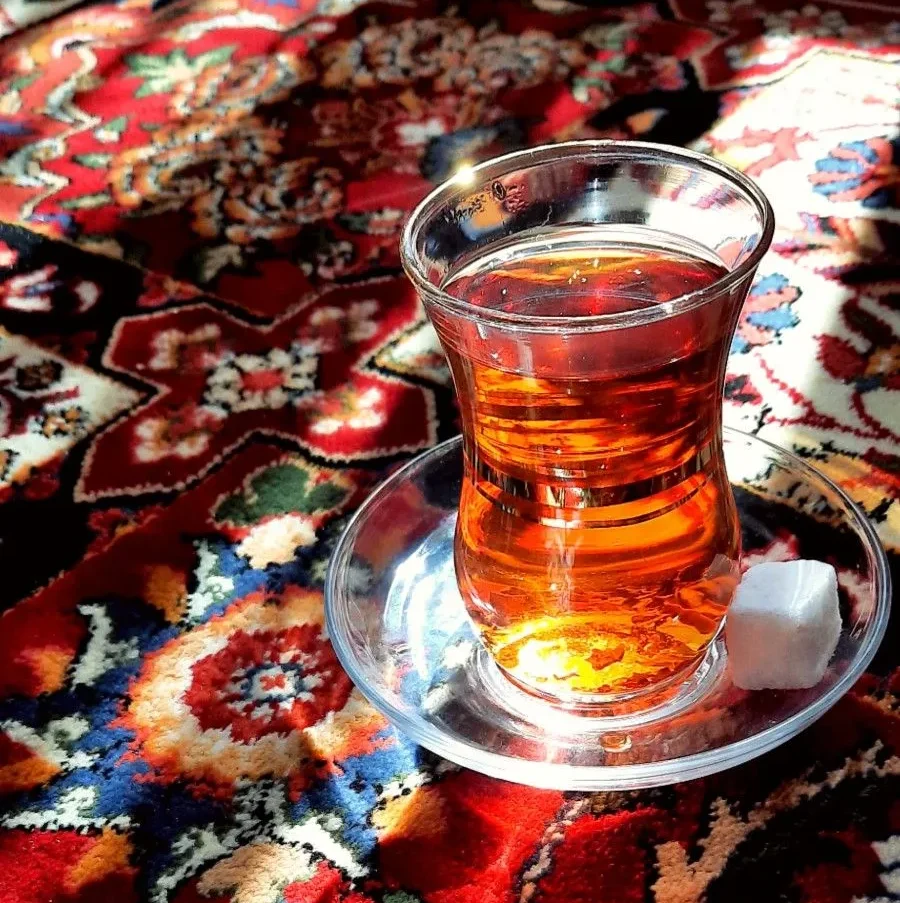Introduction of Sofre Haftsin

- Persis Collection
- 10 December 2022
- Blog
- 7 minutes
Ancient Iran was home to numerous celebrations and festivals, each marked by its own unique symbols. Among these, the Haftsin table stands out as a cherished legacy from Iranian ancestors, symbolizing the beauty of creation. Have you ever wondered about the origins of the Nowruz celebration and the tradition of the Sofre Haftsin? Discovering the history and meaning behind each item placed on the Nowruz table can inspire new ideas and make the experience of setting it even more meaningful and beautiful.
What do the seven Sins of Sofre Haft-Sin symbolize?
Each of the seven Sins of Sofre Haft-Sin is a symbol of a specific topic and carries a message with it. In the following, you will know the symbols and meanings of each part of the Haftsin table.
- Garlic (Sir) is the symbol of Ahura Mazda
- Vinegar is a symbol of the angel of immortality
- Apple symbolizes the angel of fertility and nursing
- Samano is the symbol of the Shahrivar angel or the angel of food and blessing
- Sumac is the symbol of the Avalanche angel or rain bringer
- Sabzi or Sabze is the symbol of the Ordibehesht angel or the angel of boundless and pure waters.
- Oleaster (Senjed), the angel of Khordad, or the angel of attachment
Related articles: about haft sin table

As you have seen, each of these signs is a symbol of one of the Iranian mythological angels, but it does not end here, each of these signs has its meaning, reason, and concept, which we will tell you in the rest of this article.
Quran
The first thing that Iranians put on the table when setting the Sofre Haftsin is the Holy Quran. With the coming of Islam to Iran and the conversion of Iranians and their conversion to Islam, they put the Quran on their Haft-seen table to start the new year with trust and appeal to God Almighty.
Sabze
Sabzeh is one of the components of the Haft-Sin table, which makes hearts happy with its color and freshness. Iranians plant wheat or lentils before the new year and in the last days of the year, and some prepare Sabze from the market.
In ancient Iran, 25 days before Nowruz, people built 12 columns of raw clay in the kings’ palace and planted a different type of grain on each one. If the greens grow well, they had a blessed year ahead. Sabze is a symbol of freshness and greenness and indicates human life and its connection with nature.
Apple
You must have heard that the apple on the Sofre HaftSin was a symbol of health, but this is not the whole meaning of apples! The red apple has also been a symbol of love and fertility. Our ancestors put the apple in a bowl of clear water, and put it on the Haft-Sin table, thanking God who blessed the apple and hopefully asking for love and fertility.
Samano
It is a symbol of good and blessing. It is customary in Iran that a few days before the beginning of the new year, they start the ceremony of baking Samano and believe that by doing this, good and blessings will enter their lives.
Oleaster
It is a symbol of attachment, wisdom, and fertility. An antler on a Haft-seen table is a symbol of affection. Oleaster has so many health benefits that both children and people of older age can take advantage of them.This fruit is also a symbol of acting wisely. Oleaster is placed on the table because everyone promises to do everything carefully at the beginning of the year.
Garlic
This vegetable is another component of the Haft-Sin table, which is a symbol of disinfection and cleanliness of the environment and health of the body, as well as removing sore eyes. For this reason, Zoroastrians used to put garlic on the Sofre Haftsin because they believed that the smell of garlic would ward off bad things. They peel the garlic and then put it on the table.
Vinegar
Every kitchen uses vinegar often, and as we mentioned earlier, vinegar symbolizes Amordad on the HaftSin table. This angel has been the myth of immortality of Iranians, and interestingly, vinegar remains healthy for a long time due to its compounds! It is because of this feature that it was chosen as a member of the Haft-seen table in ancient Iran.
Sumac
This spice is a combination of the word sumac and a product of a small tree whose fresh fruit tastes sour, but then it becomes acidic and salty. Sumac is a symbol of patience and tolerance and is the embodiment of the sun. This valuable plant has many properties for the body and is usable in different ways.
Other components of the HaftSin table include the following.
- Coin (a symbol of good fortune and income)
- Egg (symbol of birth and creation and a sign of sperm and race)
- Mirror (symbol of light)
- Water and fish (symbol of blessing in life)
Description of the Sofreh Haftsin
Nowruz is one of the oldest celebrations left from ancient times and has many customs. One of Iran’s most famous Nowruz ceremonies is setting the haft sin table.
Even today, the people of Iran prepare the Haft-Sin table a few hours before the time of New Year’s delivery, and the food items that begin with Sin, such as elderberry (Senjed), Sabze, Samano, coin (Sekke), apple (Sib), sumac, and garlic (Sir) are placed on the table.
With the advent of Islam in Iran, the Sofre Haft Sin of Iranians has been decorated with the Holy Quran. Each of the components of HaftSeen is a sign of concepts such as growth, birth, fertility, abundance, blessing, etc. In this article, we will introduce you to the philosophy of the Haft-Sin Table and the concepts of each Nowruz’s Sins.

Introduction of Sofre Haftseen
Haft sin is one of the most famous customs people care much at the beginning of the new solar year. On the Sofre Haft-Sin, items that start with the letter (S) are arranged, such as garlic, apples, coins, etc. In some root searches, Haft-Sin has been associated with Haft Chin, which means seven picks.
In the Sasanian religion, the number seven was considered sacred, and people planted seven seeds on seven different pillars during this period. It is notable that except for the Sins, most people put mirrors, candlesticks, Quran, a water tank, goldfish, sweets, etc. on the Sofre Haftseen.
How Haft-Sin Evolved from Haft-Shin
Iranians prepare the Haft-Sin to honor the sacred numbers seven and twelve. On the first day of spring, they place meaningful items on the table. Water and greenery show light and growth. A fire pit stands for lasting warmth. Milk means rebirth. An egg symbolizes creation. A mirror shows purity. Oleaster stands for love and fertility. An apple means the mystery of love. A pomegranate shows sanctity. A fresh coin brings blessing and wealth. A fish marks the month of Esfand. An orange stands for the Earth. Musk willow, a flower of Esfand, honors Amshaspand Sepandarms.
People also add rose water, bread from seven grains, dates, cheese, and sugar. They place pomegranate branches, willow, olives, and figs in groups of three, seven, or twelve. Finally, they put the Holy Book on the Sofreh Haftsin.
In some historical sources, Iranians used to have the Haft Shin table, which was gradually renamed. The components of the Haft Shin table were candles (Sham), wine (Sharab), sweets (Shirini), nectar (Shahd), boxwood (Shamshad), syrup (Sharbat), and anemones (Shaqayegh) or plant branches (Shakh-e-Nabat).
During the Sassanid period, Haft Shin became a common custom of Iranian people, and Shamshad was placed on the table along with the rest of Nowruz’s Shins, as a sign of greenness and immortality.
During the Sassanid period and before Islam, Iranians used to set the table called “Seven Candles” which included candles, wine, nectar, boxwood, Sharbat, and anemones. After Islam came to Iran and their “wine” was declared haram, they put its twin which was vinegar on the table, and this is how Shin changed into Sin.

History of Sofre Haftsin
The history of the Haftsin table is unclear, but some researchers think ancient Iranians made a yearly table to honor nature, with items starting with different letters.
The first signs of a table which all components started with the letter Sin date back to the 8th and 9th centuries. It should be noted that the number seven was sacred to the ancient Iranians and had great importance.
The intelligent and meaningful people of ancient Iran rarely did anything without purpose. Spreading the Haft-Sin table was also full of meaning. The experience of famines caused fear among people. Gradually, it became a custom for the family father to prepare seven specific products. Then, other family members place these items on the table.
These seven products should:
- Be obtained from the ground.
- Be edible.
- Start with Sin.
- Have plant roots.
- Be prepared from only one root.
- Have a Persian name.
By preparing these seven products, the father or head of the family promises his family a blessed year and that they will have a happy year ahead. That’s why they used to thank God in advance for the blessings on their table.

Sofre Haftsin components
For centuries, Iranians have placed seven edible green items starting with “S” on their Eid table, like garlic, vinegar, and sabzeh. After embracing Islam, they added the Quran and began the new year with its verses. If Muslims place the Quran, Avesta Zoroastrians and Kalimians place the Torah on their tables.
Fish, dyed eggs, and mirrors are also other components of the Haftsin table. Placing hyacinths, coins and Samavar has no truth. Also, the goldfish is the symbol of the new year of China. On New Year’s, the Chinese release goldfish to let life flow.
There were pomegranates in Persian Haftseen, which was a sign of fertility and love. Also, they put the red apple in a container of clean and clear water so that love and fertility will continue.
Traditional vs. Modern Elements of the Haft-Sin Table
>>>Nowadays, the Sofre Haftsin is spread on the floor or the table, and family members gather around the Haft Sin table and pray for a year full of happiness and blessings. Some people set the Haftsin table only on Eid day. Others keep it for thirteen days and throw the Sabze into the water on the last day.
Objects such as clocks, pecans, coins, samovar, and such things have no place in our Haft-Sin table! None of these have the conditions we mentioned earlier. There is no point in putting them on the HaftSin table. If you want to understand the meaning of Haftsin, know that these items have nothing to do with our ancient culture.
There were seven choices for greening the Sabze and they included seven plant seeds:
- Barley
- Wheat
- Grass pea
- Lentils
- Peas
- Beans
- Millet
Ancient Iranians grew a handful of these seeds and placed them on their doors. The sprouted seeds symbolized more blessings in the New Year.

The reason for the number seven in the Sins of Nowruz
In the ancient language, the number seven is called “Amordad,” which means life and immortality, so the ancient Iranians chose seven words as its sign and put them on Nowruz.
The ancient Iranians considered the number seven sacred and used it to represent good fortune and positive ideas. They believed in the seven colors of the rainbow. They also believed in the seven trials of Rostam in the Shahnameh. The number seven appeared in many places, such as the seven skies, seven climates, and seven days of the week. It also represented the seven angels, the seven cities of love in mysticism, and the seven celestial bodies.
The Holy Quran and Islamic teachings emphasize the importance of the number seven, and several verses and chapters mention this number clearly. For example, Hajj has seven stages, and the first reciters were seven people.










Comments